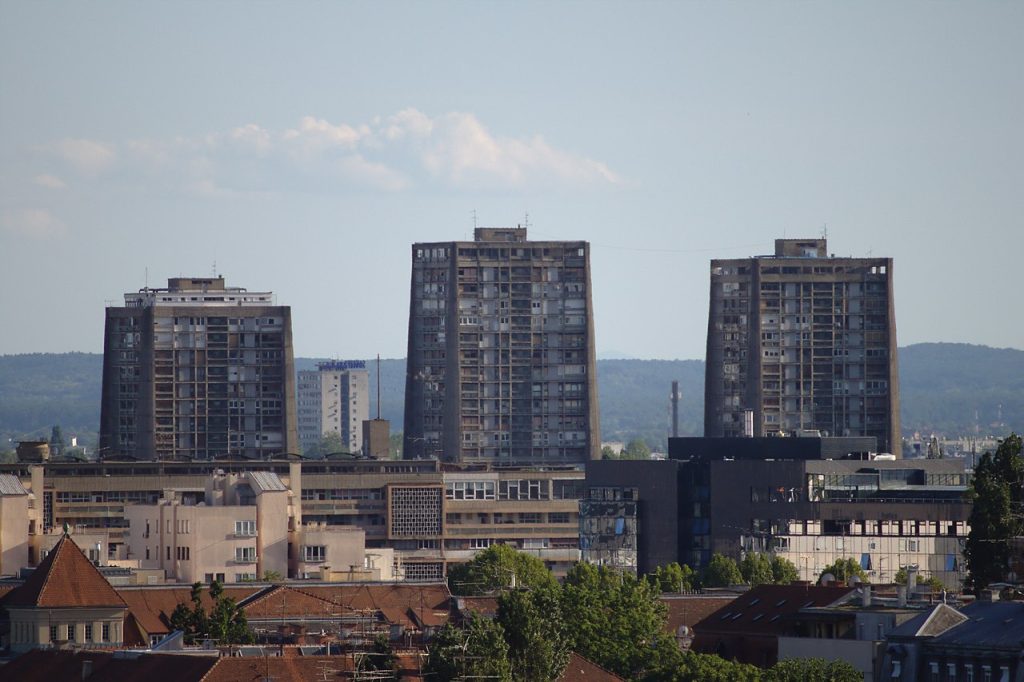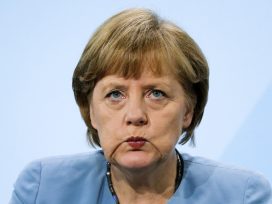Green-Left Zagreb: Municipalist resurgence in Croatia
The local election victory of Zagreb je naš/Možemo in 2021 drew on experience of activism going back well over a decade. Campaigning positively on neglected socio-economic issues, the platform operates outside the identitarian parameters of conventional Croatian politics. But reproducing success at the national level will be a challenge.
The 2021 local elections in Croatia were an unprecedented success for green and left political forces, especially in the capital of Zagreb. Headed by the political platforms Zagreb je naš (Zagreb is ours, ZJN) and Možemo (We can), the Green-Left Coalition won 40.83% of the popular vote, gaining 23 out of 48 seats in the Zagreb City Assembly. Its mayoral candidate, Tomislav Tomašević, attracted almost 200,000 voters in the run-off, a record number. Success was also achieved at the communal levels of government, where the coalition got the best result in 16 out of 17 district councils and 101 out of 218 local committee councils.
The Green-Left Coalition took over Zagreb after two decades of rule by Milan Bandić, who while mayor had been investigated in connection with a series of high-profile corruption cases, and who even spent several months of his mayoralty in prison. Over six consecutive terms in office, Bandić captured the city by creating an intricate network of clients in different public and private companies. To keep the clientelist machinery working, the city government abjectly ignored public interest defunding basic infrastructure, lowering the quality of public services and prioritizing the interests of private investors’ in urban development and planning.
The 2021 victory gained international attention not only because of the extent of popular opposition to a dramatic case of local state capture, but also the relative importance of the capital in a heavily centralised country such as Croatia. With around a quarter of the country’s population living in the Zagreb metropolitan area and an annual budget of around 2.2 billion euros, the political signficance of the city goes far beyond its borders.

View of the Richter high-rises in southern Zagreb. Source: Wikimedia Commons
Road to power
By the end of what turned out to be his final mandate, the political environment had become increasingly threatening for Bandić. The 5.5 magnitude earthquake that hit Zagreb in March 2020 proved catastrophic for the city, damaging large parts of the old town and several neighbourhoods closest to the epicentre. Although Zagreb is located in a zone of high seismic risk, the city government was utterly unprepared and proved incapable of carrying out timely and efficient reconstruction. Combined with the overall sense of crisis provoked by the Covid 19 pandemic, the consequences of the earthquake significantly undermined Bandić’s popularity. His sudden death at the beginning of 2021 spelled the end of his political party, whose name and identity revolved exclusively around the persona of its leader.
However, favourable political conditions were not the sole reason for the success of the Green Left. Much was down to long-term and systematic organising on the ground. Although formed only a few months before the 2017 local election in Zagreb, ZJN gathered groups and individuals with ten to fifteen years of experience in activism, including various social movements and advocacy NGOs. A number of events and processes played a role in the articulation of the activists’ strategies and tactics. The most important of these was the struggle against the large-scale neoliberal redevelopment of Varšavska Street in central Zagreb between 2006 and 2010. The leftwing activist field continued to develop in succeeding years through new organisations and collectives emerging in connection with student protests against the defunding of public higher education in 2009. Later, in 2014, a coalition of organisations and trade unions successfully stopped the privatisation of Croatian Motorways. Combined with consistent disappointment in disinterested and detached centre-left parties, these experiences led the activists’to gradually reorient their strategy towards the electoral competition.
Due to its experience and campaign skills, ZJN and its coalition partners managed to win four seats in the City Assembly in 2017 with only a few months of preparation. Despite having only four seats under its control, ZJN soon positioned itself as the main challenger to Bandić. Most of the opposition parties were either completely passive in the city assembly or did not confront the Bandić administration on any substantive issues. The ZJN campaign was innovative in that it insisted on questions of access to public services, quality of public infrastructure, and urban problems specific to each city district. Instead of trying to accomodate to the usual framework of political conflict in Croatia, which revolves around issues such as religious and national identity, and the legacy of the wars of the nineties, the Green-Left Coalition tried to draw more public attention to inequality, workers’ rights and theaccessibility of public services.
In early 2019, on the occasion of the EU Parliamentary Election, part of the activists founded Možemo as complementary party to ZJN at the national level. Despite gaining only 1.79% of the vote, Možemo slowly but steadily raised its public profile by tactically emphasising its activity on the topics that other oppositional political parties were ignoring. In 2020, after forming a Green-Left coalition with several other small political parties, it achieved 6.99% of the popular vote, winning six seats in the Croatian parliament. The entry of the Green-Left coalition into parliament further consolidated its visibility in the mainstream media and boosted its electoral prospects. Due to its expansion to the national level, in the 2021 local elections, the Green-Left coalition not only won in Zagreb but also succeeded in entering eight city councils, four county assemblies and even won the mayoral seat in Pazin.
Zagreb je naš and Možemo are no exceptions in the post-Yugoslav space. Similar cases of new left political parties can be found in other countries, particularly Slovenia and Serbia. Originating in social movements, collectives and non-governmental organisations established in the 1990s and 2000s, many activists and activist groups have changed their focus during the last decade from nonelectoral strategy, (i.e. advocacy, litigation and protest campaigns) to a strategy based principally on running for office. Inspired by high-profile cases such as Barcelona en Comú, Podemos and Syriza, activist groups in the region have made numerous attempts to combine movement-based organising with party-based organising. However, the victory of the Green-Left Coalition in 2021 was the first time one of them had gained an opportunity to take over a crucial executive office almost independently of established liberal and centre-left parties.
Some significant victories
In a city ravaged by long-term mismanagement, many problems have had to be addressed urgently. The city’s fundamental infrastructural weaknesses had been ignored for decades: traffic congestion is at tipping point, the water supply network is literally exploding due to lack of maintenance, and housing prices are out of control. The city was on the brink of bankruptcy when ZJN took over from the Bandić administration, meaning that it will take years for the new administration to fully restore the basic functioning of the city.
Twenty-one months into the government of Možemo in Zagreb, it is clear that the expectations accompanying the resounding popular mandate are not easy to fulfil. The centrality of Zagreb means that all of the projects undertaken by the city administration are closely scrutinised by the national media, exposing the Green-Left Coalition to constant attack.
But the new administration has already achieved several important goals. Its priority from the outset has been the reconstruction of schools and other public institutions damaged in the 2020 earthquake. Reconstruction, which the previous administration barely even started, has had to be efficient and fast, not least because of the strict deadlines stipulated in by the EU Solidarity Fund, where most of the funding is coming from. By the beginning of 2023, the city has been able to fully reconstruct and reopen all the elementary schools damaged in the earthquake.
The administration has started introducing many long-awaited reforms, most prominently of its waste management system, which played an essential part in the former mayor’s clientelist network. The outsourcing of various elements of the system is being reversed and incentives introduced that, in the long run, should motivate citizens to sort and recycle more than before. The new administration has also started to plan an ambitious investment cycle to improve transport infrastructure and the water supply network.
In addition to reforms of public services, the public institutions and companies managed by the city have all reinstated collective agreements with employees, increasing salaries and ameliorating working conditions. Particularly important was reversing the predominant trend of outsourcing labour. Workers in all public institutions and companies with outsourced contracts were promptly insourced and offered regular contracts. Despite the overall improvements, however, the long-term neglect of workers’ rights and the pressure of the reforms prompted waste management workers to strike at the end of January. Successful negotiations between unions, management and the city administration brought the strike to an end after four days, but it showed that workers’ rights must continue to be prioritised.
Among the reforms in social and healthcare policy, one of the most significant changes has been the reintroduction of access to abortion at the Sveti Duh Clinical Hospital, one of the biggest hospitals in the country and owned by the city of Zagreb. Although abortion has been legally regulated since 1978, access has been hindered in recent years by an increase in the number of ‘conscientious objectors’ among medical professionals across Croatia. In 2015, Sveti Duh became one of the hospitals to stop undertaking abortions, after all of its medical personnel refused to participate in the procedures. The new management replaced the staff and reintroduced the abortion clinic, an achievement that has a particular symbolic value in the context of an increasing conservative backlash against women’s rights in Croatia.
Another notable policy measure was abolishing the ‘parent-educator’ scheme. Introduced in 2016, this system of financial compensation for unemployed parents of preschool-aged children turned out not just to be extremely expensive but also counterproductive. Instead of pumping around 90 million euros a year into sustaining the measure, the new administration shifted the funds towards increasing the accessibility and capacity of kindergartens. The decision was very positively received by the public, especially given its redistributive purpose. However, a coalition of ‘parent-educators’ and conservative Christian advocacy groups issued a legal complaintand succeeded in temporarily reversing the city’s decision. While the city did eventually manage to abolish the scheme, the case showed how even very popular decisions can easily be challenged.
Predicaments of power
Although all these reforms and measures were contained in the campaign manifesto of the Green-Left Coalition, they have provoked various criticisms. The administration has been confronted with a significant backlash from political opponents, including private companies interested in preserving the old outsourcing practices, and far-right and conservative NGOs that feel threatened by the Green-Left agenda. The fact that the governing party at the national level is the Croatian Democratic Union (HDZ) is also an obstacle. As the dominant rightwing political party and head of the national government for 24 out of the last 32 years, the HDZ obsessively tries to preserve the status quo. Reforms undertaken by the city government are perceived as a threat, even if the Green-Left Coalition does not competing directly with the HDZ for votes.
Post-earthquake, the HDZ proved incapable of carrying out its responsibilities in the reconstructing private housingassigned assigned to it by a special law. Although the city administration attempted to be constructive and support the ministries and other state institutions, not a single privately-owned house in the city has been reconstructed by the state as of March 2023. The incompetence of state institutions wasvery clearly demonstrated in this case and might influence the city’s capacity to undertake more ambitious investments, where collaboration with the national government is unavoidable.
It seems, then, that a landslide election victory does not mean full power. As mayor Tomašević has noted on several occasions, inheriting responsibility for a massive system is like ‘taking over a plane in mid-flight’. In 2021 the city was struggling with more than 110 million euros (860 million kuna) of unpaid claims and more than one billion euros (8.2 billion kuna) of debt. Financial consolidation was one of the early successes of the city government, even though this necessarily constrained public investment.
But financial chaos was not the only problem facing the new city government. Its predecessor had steadily and systematically transformed the city’s bureaucratic apparatus into a system of spoils, meaning that the new administration had to reinstate professional standards and codes of conduct among the city’s civil servants. The Croatian local authority system heavily constrains mayors’ choice of key officials within their own administrations, including the heads of city departments. Instead of mayors being able to appoint heads of offices at their discretion, standard practice in many countries, each post must be filled through a long and complicated process of public competition. Although this rule might make sense for professional civil servants, the heads of city departments should be willing to implement the policies of the governing political party. The ‘depoliticisation’ of the executive was not a problem for the former administration, which habitually faked public competitions and appointed individuals without even minimum formal prerequisities. However, the new administration decided that it could not afford to disobey the procedures, which meant that effective change at the level of senior civil servants took around a year and a half.
At the same time, the power of the central city government in appointing the heads of public institutions is excessive. The city of Zagreb is in charge of hundreds of public institutions, including kindergartens, schools, student dorms, hospitals, retirement homes, museums, theatres and other types of public institution. Each of these institutions is governed by a managing board whose members also have to be appointed directly by the city. Thisbloated system means that an a change of city government brings thousands of new appointments.
In addition to the city’s administrative bodies and public institutions, the new government also had to take charge of Zagreb Holding, the public company that manages the bulk of the city’s infrastructure through its twelve branches, five subsiduaries and around 7000 workers. As noted by Paul Stubbs, Zagreb Holding could soon become the space of growing tension between a Green-Left political agenda and the neoliberal logic of corporate governance.
National perspectives
It is still too early to talk about the Green Left’s prospects in the next local elections in Zagreb, which are due to take place in May 2025. Before that, Croatia will hold parliamentary, EU and presidential elections in 2024. Public opinion surveys over the past year show that, at the national level, Možemo has stabilised its position as the third most popular political party with some 10% of the vote, after the Croatian Democratic Union (HDZ) and the Social Democratic Party (SDP). Možemo and ZJN have also started the long-awaited process of merging into a single organisation, together with another smaller Green-Left Coalition member – the New Left. Broadly supported by members of all three organisations, the merger should provide for a more efficient structure with greater intra-organizational accountability and better communication, as well as enable the expansion of membership.
At the national level, the current strategy of the Green-Left Coalition, SDP and other oppositional actors largely focuses on the negative impact of HDZ hegemony. While no decisions have been made, there is a possibility that Možemo will try to contest HDZ through a coalition with SDP. But entering a coalition with SDP could also worsen the position of Možemo electorally. With the polls showing consistent support for HDZ between 25% to 30%, challenging the the centre-right party will in any case be a demanding task.
Although anti-HDZ rhetoric might attract some voters, Možemo will need to continue positioning itself as a key actor on healthcare, education and housing. After all, positive campaigning on socioeconomic issues that many voters feel are left out of the political debateisone of the formulas of its success.
Over the last twenty-one months, the Green-Left administration has achieved a lot and has initiated some long-term processes that will hopefully continue in the future. Whether and how citizens will perceive this remains to be seen. In the short term, national-level presence and a good framing strategy will be important. In the long term, maintaining and strengthening electoral popularity comes from successful groundwork in political organising. This, in turn, demands a democratic and efficient organisational structure. The efforts of organizing are increasingly demanding, especially for the activists working in city district councils and local committees, which often serve as mediators between the communities and various elements of the city government. To keep the organisers motivated, the Green-Left Coalition will have to make sure that the organisers’ work is adequately supported.
Moreover, it will have to ensure that old and new members, involved at different levels of government from the neighbourhood level up, continue to feel that their participation in the organisation’s democratic life is purposeful and meaningful. This requires continuous rethinking and development of organizational structure, so as to balance the tension between highly dynamic parliamentary and executive politics on the one hand, and intra-organizational democratic processes on the other. It also presumes a proactive role of the Green-Left Coalition in maintaining and developing its connections with social movements and other organizations on the ground in the years to come.
The author is a member of Zagreb je naš and Možemo but holds no public or party functions within either platform.
Published 30 March 2023
Original in English
First published by Eurozine
© Karlo Kralj / Eurozine
PDF/PRINTIn collaboration with
In focal points
- Living dead democracy
- Why Parliaments?
- Spelling out a law for nature
- No more turning a blind eye
- The end of Tunisia’s spring?
- Protecting nature, empowering people
- Albania: Obstructed democracy
- Romania: Propaganda into votes
- The myth of sudden death
- Hungary: From housing justice to municipal opposition
Newsletter
Subscribe to know what’s worth thinking about.
Related Articles

After six months of protests, there are grounds for hope that the tide is turning in favour of the Serbian student movement: first, the unification of the opposition around the movement’s demand for new elections; second, the emergence of a strategic alliance between the students and the EU.

Outrage and moral panic have become driving forces in global politics – but what role should emotions play in democratic governance? On the new episode of Standard Time, researchers examine the influence of moral emotions and their implications for political life.






